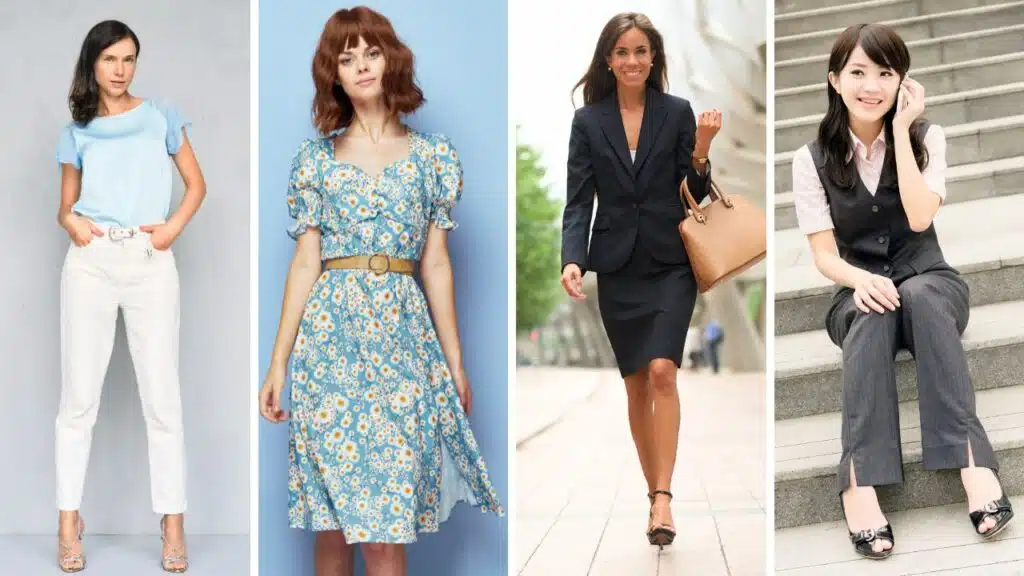Business casual for work is the most popular attire trend in the world of office fashion, with 41% of people citing it as their normal outfit during work hours. With a blend of office workers, work-from-home employees, and hybrid workers, dressing professionally and comfortably has become more relevant than ever.
Business casual has become the standard dress code for many companies across various industries. It balances professionalism and comfort, making it a popular choice among employees. However, there can be confusion as to what exactly constitutes business casual.
What is Business Casual?
Business casual is an office dress code that falls between formal and casual wear. It allows for more relaxed and comfortable clothing options while still maintaining a professional appearance. Business casual attire is typically appropriate for office settings, meetings, and other professional events.
The overall goal of business casual is to strike a balance between looking polished and feeling comfortable. It should show professionalism without being too stuffy or formal.
A Guide to Dressing Business Casual for Work
Every business casual wardrobe will involve the following key pieces of clothing. These items can be mixed and matched to create several different outfits while still maintaining a professional look.
Dressy Tops
For women, blouses, button-down shirts, and sweaters are all suitable options for business casual. Shirts should be well-fitting but not too tight and lack graphic designs that typically make them too casual.
As for men, tight-knit sweaters and collared short or long-sleeved shirts (including polo shirts) in solid colors or subtle patterns work well for business casual. In some instances, a solid color, well-fitting t-shirt might be appropriate, particularly when worn with a blazer.
Jackets and Blazers
Jackets and blazers are a business casual dress code staple. They can never go wrong with their timeless and polished look and can add structure to any outfit.
Women can choose from various styles, including blazers, cardigans, or jackets in neutral colors or subtle patterns. Men’s options include suit jackets, sports coats, and blazers in solid colors or subtle patterns.
Slacks, Pants, and Skirts
Both women and men can opt for dress pants or slacks in neutral colors such as black, navy blue, or grey. Chinos, also known as khakis, are acceptable for a casual business look. For women, skirts that hit just above the knee or longer are appropriate. Skirts should not be too tight or revealing.
Shoes
Shoes are an essential part of any business casual outfit. Closed-toe shoes with a modest heel or flats are both acceptable options for women. Men’s footwear should be dressier than sneakers but less formal than oxfords or dress shoes.
Other Considerations
What is on and off the table for casual wear ultimately depends on a specific company’s work atmosphere and normal dress code. In some office settings, t-shirts may be a no-no. Yet, some companies may be okay with t-shirts, even graphic tees, dark blue jeans, and more casual shoes such as white tennis shoes and sandals (for women).
Dos and Don’ts for Business Casual
To summarize, here are some dos and don’ts to consider when dressing in business casual attire for work. In reality, paying attention to what not to do is more important.
Dos:
- Do opt for well-fitting clothes that are neither too tight nor too loose.
- Do choose modest tops that lack bold prints or graphics (unless you judge otherwise).
- Do add structure to your outfit with a jacket or blazer. If it’s too warm to wear all day, keep it on hand for last-minute meetings or lunch with the boss to quickly dress up your outfit.
- Do choose dress pants, slacks, or skirts that are appropriate in length and fit comfortably. There shouldn’t be any stains, frays, holes, or wrinkles.
- Decide what footwear is appropriate for your office and opt for well-maintained shoes that look professional without scuffs.
- Do find a style that you’re comfortable wearing that also fits with your industry or company’s overall culture.
Don’ts:
- Don’t wear anything too tight, revealing, or with bold prints or graphics.
- Don’t opt for casual pieces such as loose t-shirts, flip-flops, tennis shoes (specifically for athletic use), and athletic wear. Save these items for the weekends.
- Don’t choose skirts that are too short or tight.
- Don’t neglect your overall appearance. Pay attention to grooming and hygiene, such as well-groomed hair, neat nails, and a clean-shaven face for men.
- Don’t forget about your company or industry’s dress code or culture. What may be appropriate for one office may not be acceptable in another.
- Don’t underestimate the power of a professional, well-put-together outfit. Dressing in your best business casual clothing can boost your confidence and make a positive impression on clients and colleagues.
Outfit Examples That Look Sharp
Here are some examples of business casual attire for both women and men to give you an idea of what is appropriate in the workplace. Remember that these are just general ideas, and it’s always best to check with your company’s dress code policy.
Business Casual for Women:
- A blouse or button-down shirt paired with dress pants or a knee-length skirt and flats.
- A blazer or cardigan layered over a conservative dress with closed-toe shoes.
- A knee-length dress with a modest neckline and sleeves paired with heels or flats.
Business Casual for Men:
- A collared shirt (button-up or polo) paired with dress pants or chinos.
- A sports coat or suit jacket layered over a button-down shirt with dress pants.
- A solid-colored, well-fitting t-shirt paired with a blazer, dress pants, and dress shoes.
Tips for Adding Personality to Your Look
Can business casual be modern and personalized? Absolutely. While the dress code may lean towards conservative, there are still ways to showcase your personal style and stand out in the office. Here are a few tips:
- Add pops of color with accessories such as statement jewelry or a patterned tie.
- Experiment with different textures like a tweed blazer or silk blouse.
- Mix and match patterns, but keep them subtle and in the same color family.
- Invest in quality, well-tailored pieces that will last and elevate your overall look.
- Don’t be afraid to incorporate trends, but make sure they still fit within the dress code guidelines.
Overall, business casual allows for some flexibility while still maintaining a professional appearance. There is no right or wrong way to dress for business casual, as it ultimately depends on the company.
By following these guidelines and incorporating your own personal style, you can create a polished and modern look that is appropriate for the workplace.
Business Casual FAQ:
Are jeans okay for business casual?
This really depends on the company’s dress code. In most cases, jeans are not considered business casual. However, some offices may allow for dark, well-fitted, straight-leg jeans as long as they are paired with a more polished top and shoes.
Can I wear sneakers in a business casual setting?
In general, sneakers are not appropriate for business casual. However, if your office culture is more laid-back and casual, clean and simple sneakers may be acceptable.
Can I wear open-toe shoes in a business casual environment?
Open-toe shoes such as sandals or flip-flops are often not considered appropriate for business casual. Dressy, open-toed flats may be appropriate for seasonal business casual in the summer months. Closed-toe shoes, such as flats or heels, are a safer choice.
Can I wear makeup and accessories in a business casual setting?
Yes! Just make sure to keep these elements conservative and professional. Opt for neutral makeup looks and minimal jewelry that complements your outfit without being too flashy or distracting.
In what instances would it be better to dress up more professionally?
Being well-dressed will almost always play in your favor. Instances include a job interview, meeting with the boss, when trying to get a promotion or raise, and attending important meetings or events with clients. It’s always better to err on the side of caution and dress more professionally in these situations.
What should I do if my company doesn’t have a specific dress code?
If your company doesn’t have a specific dress code, it’s best to follow the general guidelines for business casual attire. If you are starting a new job, it’s always best to dress conservatively until you get a feel for the culture.
How can I transition my outfit from day to night?
You can simply swap out a few key pieces to transition your business casual outfit from day to night. For example, change into heels instead of flats, add a blazer or statement jewelry, and touch up your makeup. This will instantly elevate your look for after-work events or outings.
Related Articles
JayDee Vykoukal
JayDee is a mom, writer, and Doctor of Physical Therapy. She’s passionate about helping women live their best lives through community and education. Outside of her work as a health and mom blogger, she loves traveling the world and exploring the great outdoors with her family.



